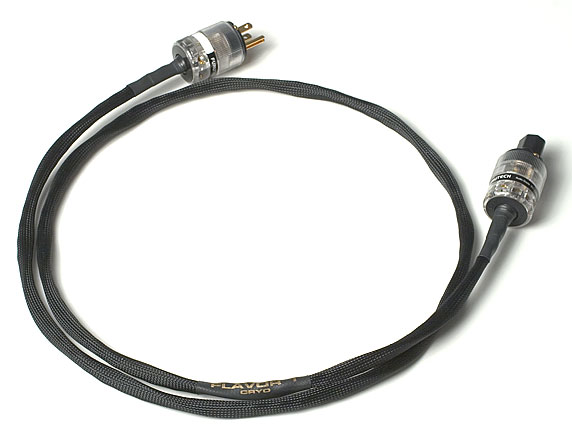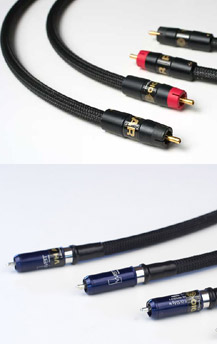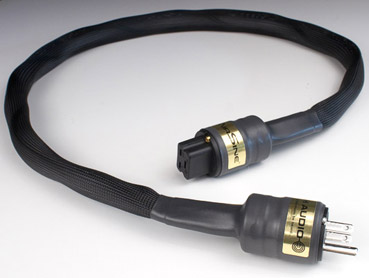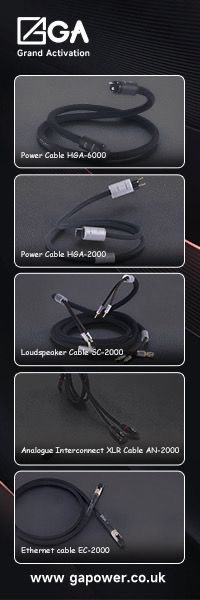VH Audio Cables
| VH Audio Cables |
| Another Most Wanted indeed |
|
|
|
February 2007 |

Enter VH Audio
I first came across Chris VenHaus years ago, when I stumbled on his enthusiast site while surfing the ‘Net for DIY cable recipes. Back then, Chris had a crazy-looking recipe for speaker cables made out of CAT5 ethernet cable. He also had lots of other recipes for cables based on coaxial cable for interconnects and other stuff. The CAT5 speaker cable was the only one I attempted. It wasn’t terribly fun for someone like me—I just didn’t have the craftsman’s patience or dexterity to do it justice.
Fast-forward a few years. Chris VenHaus has taken his passion as a cable enthusiast and turned it into a full-fledged business: VH Audio. He now sells ready-made cable products, along with parts and kits to roll your own. I contacted Chris for a review of some of his products after purchasing a VH Audio Flavor 4 power cord for my Sony SCD-777ES.
The Package
When I first got in touch with Chris, the product I really wanted to review was his new AirSine power cord. According to Chris, the AirSine is his cost-no-object assault on state-of-the-art power cabling. Now, I was already very impressed with the Flavor 4 cord that I’d purchased for my own use. The Flavor 4 costs just $159.99 for a 4-foot version. The AirSine, on the other hand, weighs in at a considerably higher price point of $699.99 for the same length. That’s quite a jump in price. Would there be a similar jump in performance?
Chris ended up sending me not only the AirSine, but also two sets of his interconnects: the Spectrum and Pulsar. Both were finished with WBA NextGen “locking” RCAs. A note about these NextGen RCA connectors: I believe the term “locking” to be used very liberally with these things. Unlike the older locking RCAs from WBA, the NextGens don’t really lock. Truth be told, I didn’t really like their construction and I have no idea if they do sound better than the older types. Personally, my impression is that a connector like the Eichmann bullet plug would make a better termination. But this is just purely subjective speculation on my part.
First Things First
 I’m going to give you a quick rundown of my impressions of the Pulsar (top right) and Spectrum. The rest of my review will focus mainly on the AirSine power cord. To my ears, the Pulsar and Spectrum share very similar characteristics: big, expansive soundstaging, combined with taut, punch bass. In direct comparisons against each other, I found the Spectrum to possess slightly more “air” around instruments and hence, the impression of a bit more openness. The Pulsar sounded just a little bit veiled when I swapped them in.
I’m going to give you a quick rundown of my impressions of the Pulsar (top right) and Spectrum. The rest of my review will focus mainly on the AirSine power cord. To my ears, the Pulsar and Spectrum share very similar characteristics: big, expansive soundstaging, combined with taut, punch bass. In direct comparisons against each other, I found the Spectrum to possess slightly more “air” around instruments and hence, the impression of a bit more openness. The Pulsar sounded just a little bit veiled when I swapped them in.
Both cables fared exceedingly well against better-known and highly regarded competition. First up, the Analysis Plus Solo Crystal Oval interconnects. Both the Pulsar and Spectrum sounded punchier than the Solo Crystals, which had more “rounded” or warmer balance to them. The Pulsar and Spectrum also sounded more expansive and open. On the other hand, images seemed slightly denser with the Solo Crystals. If I had to point to one obvious difference, I’d say that the Pulsar and Spectrum are both more neutral, whereas the Solo Crystal imparts a bit more of a romantic character to the music. I think which cable you prefer will be highly dependent on associated components in your system.
The next cable I threw in the ring against the Pulsar/Spectrum duo was the Shunyata Research Aries. This time, I found that the Aries managed to combine the best characteristics of the VH Audio cabling—punchy, expansive sound—with the Solo Crystal’s image density. For me, I preferred the Aries over both Spectrum and Pulsar. It sounds easy for me to say this now, but I had the VH Audio cables in my system for a LONG time and for much of that time, it was a dead heat between all three cables. I emphasize this now, because on the written page, these differences seem magnified; in the real world, it takes extensive and intensive listening sessions to bear them out. Also bear in mind that the Aries is now discontinued and its replacement, the Altair, starts at $1000 for a meter pair. In this light, both the Pulsar and Spectrum are excellent values and I wouldn’t hesitate to recommend either cable to anyone. Frankly, the VH Audio cables are no-brainers, especially when you consider that Chris VenHaus gives you 60 days to try them with a money-back guarantee.
AirSine: The Next Big Thing?

The AirSine is one massive cable. In appearance, it reminds me of an old Kryptonite bicycle lock I once had. Thankfully, the AirSine doesn’t weigh nearly as much. I was VERY pleasantly surprised by the fact that, despite its massive appearance, the AirSine was very easy to handle and way more flexible than the Flavor 4 power cord. I initally tried the AirSine on both my Sony SCD-777ES and my Ayre AX-7e integrated amplifier, but found that it really made the biggest difference on the Sony. This is pretty much what I’ve always found with power cables—they seem to make more of difference on sources than amplifiers. For the purposes of this review, my comments will be exclusive to the use of the AirSine on the SCD-777ES. I also want to point out that the Sony was plugged into a Shunyata Hydra 2 power conditioner, which was plugged into my wall outlet with a Shunyata Taipan Helix power cord.
 Let’s cut to the chase: the VH Audio AirSine is a spectacular power cord and it gets my nomination as a Stereo Times Most Wanted Component. I always feel a bit silly when I tell my non-audiophile friends and acquaintances that cables have a sound. I feel even sillier when said cables happen to be power cables. But I think the AirSine will make a believer out of just about anyone. The change that the AirSine brought to my system was not at all difficult to discern, and it happened the very first time I popped a CD into the Sony and hit the play button. That first track I played was “Dance Me to the End of Love” from Madeliene Peyroux’s Careless Love album [Rounder 613192]. Amazingly, the music sounded louder. Yes, that’s right, it sounded as if I’d turned up the volume. But thanks to my Ayre integrated’s front panel display, I knew that the output level was where I’d always had it.
Let’s cut to the chase: the VH Audio AirSine is a spectacular power cord and it gets my nomination as a Stereo Times Most Wanted Component. I always feel a bit silly when I tell my non-audiophile friends and acquaintances that cables have a sound. I feel even sillier when said cables happen to be power cables. But I think the AirSine will make a believer out of just about anyone. The change that the AirSine brought to my system was not at all difficult to discern, and it happened the very first time I popped a CD into the Sony and hit the play button. That first track I played was “Dance Me to the End of Love” from Madeliene Peyroux’s Careless Love album [Rounder 613192]. Amazingly, the music sounded louder. Yes, that’s right, it sounded as if I’d turned up the volume. But thanks to my Ayre integrated’s front panel display, I knew that the output level was where I’d always had it.
Subjective loudness was just the beginning. Ms. Peyroux’s vocals came across in a beautifully detailed and expressive way, emerging out of nothingness to fill the space of my room. Every detail seemed amplified and magnified—big, bold, vocal imaging combined with heroic instrumentation. I was blown away. And this was just on the very first listen!
Over the next few months, the AirSine did nothing to change my first impression of it. If anything, its prowess as a power cable only continued to grow in my estimation. One of the things I really enjoy about listening to vinyl is that music never seems artificially confined like it is on CD.  While the AirSine didn’t magically transform my Sony into the equivalent of a turntable, it did much to move the sound in the right direction. I realized that the subjectively higher volume I was hearing was a result of the dramatic increase in overall clarity that the AirSine brought to my system. Every detail was just easier to hear, easier to discern, and as a result, easier to listen to. There also seemed to be much better delineations between instruments and voices, along with a more defined sense of three-dimensional space in the soundstage. One of my favorite torture tests in a review is Track 3, “The Battle,” from the Gladiator soundtrack. I use this track to see how well any given component is able to sort out all the instrumental details when the music reaches its climax. The best components are able to retain a sense of texture about the sound, even while the music itself communicates the chaos and cacophony of war. With the AirSine in place, I heard the full power of this track in my system for the very first time. I had always thought that there was no escaping the fact that “The Battle” is, quite honestly, a compressed-sounding recording. The AirSine showed me that part of the fault lay in the power delivery to my CD player—the track was actually capable of sounding better than it ever did, but how do I go back to a pre-AirSine state of listening???
While the AirSine didn’t magically transform my Sony into the equivalent of a turntable, it did much to move the sound in the right direction. I realized that the subjectively higher volume I was hearing was a result of the dramatic increase in overall clarity that the AirSine brought to my system. Every detail was just easier to hear, easier to discern, and as a result, easier to listen to. There also seemed to be much better delineations between instruments and voices, along with a more defined sense of three-dimensional space in the soundstage. One of my favorite torture tests in a review is Track 3, “The Battle,” from the Gladiator soundtrack. I use this track to see how well any given component is able to sort out all the instrumental details when the music reaches its climax. The best components are able to retain a sense of texture about the sound, even while the music itself communicates the chaos and cacophony of war. With the AirSine in place, I heard the full power of this track in my system for the very first time. I had always thought that there was no escaping the fact that “The Battle” is, quite honestly, a compressed-sounding recording. The AirSine showed me that part of the fault lay in the power delivery to my CD player—the track was actually capable of sounding better than it ever did, but how do I go back to a pre-AirSine state of listening???
The Aftermath
I mentioned earlier in this review that I used the AirSine plugged into a Shunyata Hydra 2 conditioner, which in turn was plugged into the wall via a Shunyata Taipan Helix. In all cases, the system sounded better when the Hydra 2 was in the chain—backgrounds seemed blacker and images seemed to be more defined and tighter. I was also able to directly compare the AirSine head-to-head against another Taipan Helix. This comparison’s pretty useful because the cables retail for approximately the same price. However, the AirSine came out ahead rather easily. Don’t get me wrong, the Taipan Helix is a very good cable, but when compared to the AirSine, I found the latter to be better in just about every way. Most notably, the AirSine simply made my CD player sound more dynamic and robust, allowing more detail to flow through. The Taipan Helix imparted a warmer glow to everything—in some systems, this might be just the thing. But in my system, and for my listening preferences, the AirSine proved to be a much more compatible performer.
Addendum
Chris let me hang on to his cables for an unusually long time. Because of this, I was able to hear the AirSine as my system evolved (interested readers can take a look at my updated associated components list.) While my SCD-777ES has remained constant, I’ve gone through different speakers, amplifiers, digital-to-analog converters and more. I sincerely believe, having lived with the AirSine for about a year or more, and through multiple associated component changes, that its $699 price tag is more than justified. The AirSine isn’t just another step in the upgrade merry-go-round, it’s a destination. And that’s precisely why it’s my Most Wanted Component.
Eujin Hong
__________________
VH Audio products reviewed
AirSine Power Cord: Starting at $699 for 4 ft. length. Additional options available for terminals.
Pulsar interconnect: Starting at $154.99 per .5 meter pair. Additional options available, including cyro treatment and terminations.
Spectrum interconnect: $359.99 per .5 meter pair. Additional options available, including cyro treatment and terminations.
Web site: http://www.vhaudio.com
![]()
Don’t forget to bookmark us! (CTRL-SHFT-D)
Stereo Times Masthead
Publisher/Founder
Clement Perry
Editor
Dave Thomas
Senior Editors
Frank Alles, Mike Girardi, Russell Lichter, Terry London, Moreno Mitchell, Paul Szabady, Bill Wells, Mike Wright, and Stephen Yan,
Current Contributors
David Abramson, Tim Barrall, Dave Allison, Ron Cook, Lewis Dardick, John Hoffman, Dan Secula, Don Shaulis, Greg Simmons, Eric Teh, Greg Voth, Richard Willie, Ed Van Winkle, Rob Dockery, Richard Doron, and Daveed Turek
Site Management Clement Perry
Ad Designer: Martin Perry





Be the first to comment on: VH Audio Cables